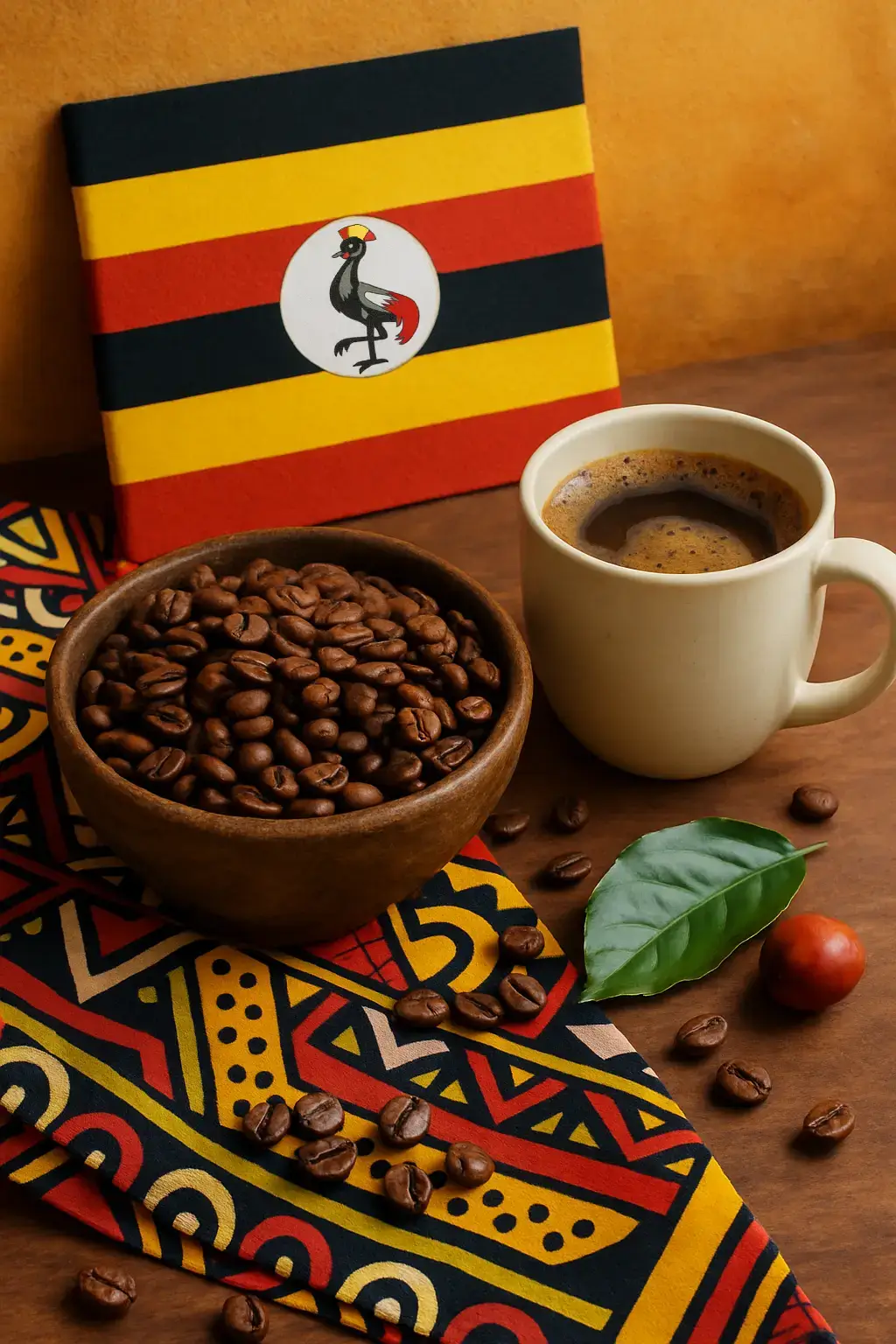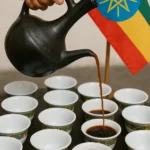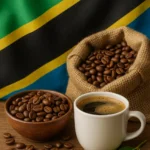Ugandan coffee is known worldwide for its unique qualities. This East African nation plays a big role in the global coffee market. Uganda grows both native Robusta and fine Arabica beans. Its different farming regions, like those around Lake Victoria, help create this wide range of coffees. This variety shows how important coffee is to Uganda’s economy.
- Main types of Ugandan coffee: Robusta vs. Arabica
- What defines Ugandan Robusta coffee?
- What defines Ugandan Arabica coffee?
- Native varieties and unique biodiversity of Ugandan coffee
- How processing methods change Ugandan coffee flavors
- Washed processing and its effect on Ugandan coffee
- Dry processing and its effect on Ugandan coffee
- Uganda: A rising star in the global coffee market
- How Uganda became Africa’s top coffee exporter and a global contender
- Ugandan coffee: An economic powerhouse driving Uganda’s growth
- What makes Ugandan coffee special?
- Cultivating a sustainable future for Ugandan coffee
- Environmental stewardship and climate resilience for Ugandan coffee
- Empowering farmers and promoting inclusivity in Ugandan coffee
- How traceability and market access help Ugandan coffee
- The future outlook for Ugandan coffee
Main types of Ugandan coffee: Robusta vs. Arabica
Uganda mainly grows two kinds of coffee: Robusta and Arabica. Robusta makes up most of the country’s harvest. Both types grow well across Uganda’s diverse landscapes. Farmers plant Coffea canephora (Robusta) and Coffea arabica (Arabica) everywhere. Each one brings its own special taste to Ugandan coffee.
Ugandan coffee types: Robusta vs. Arabica
| Feature | Robusta | Arabica |
|---|---|---|
| Production share | About 80% | About 20% |
| Altitude | 900–1500 meters | 1300–2300 meters (optimal 2100–2400 meters) |
| Flavor profile | Bold, caramel, spicy, herby, nutty, tropical fruit, chocolate, nut, spice | Complex, refined, dried fruit, chocolatey, spicy, herby, citrus, berry, floral, wine-like |
| Body | Smooth, bold, heavy-bodied | Balanced |
| Acidity | Often unique bitter or salty tastes | Balanced acidity |
| Aftertaste | Spicy or dried fruit | Clean, balanced citrus |
| Varieties | Nganda, Erecta, UG 5 | Kent, Typica, SL-14, SL-28, Bugishu |
| Processing | Mainly dry (natural) | Mainly washed (wet) |
| Key growing regions | Lake Victoria basin, Western Uganda, Rwenzori Mountains, West Nile | Bugisu (Mount Elgon), Peaks of the Moon (Rwenzori Mountains), West Nile (higher altitudes) |
What defines Ugandan Robusta coffee?
Ugandan Robusta has bold flavors. It makes up about 80% of all coffee grown there. This coffee comes from Uganda’s rainforests. It grows well at lower elevations, usually from 900 to 1500 meters high. Expect a caramel, spicy, or herby smell. You might taste nutty, tropical fruit, or spicy notes. Some cups have bitter or salty hints, with a spicy or dried fruit finish. Ugandan Robusta is smooth, bold, and full-bodied. Often, you’ll find notes of chocolate, nuts, spice, and tropical fruit. Key Robusta types include the wild native strains Nganda and Erecta. Nganda has a lot of caffeine and a natural sweetness. Farmers also commonly grow UG 5. Robusta grows in many parts of Uganda:
- the vast Lake Victoria basin,
- western Uganda,
- the Rwenzori Mountains region near the Democratic Republic of Congo border,
- the West Nile area in northern Uganda.
These areas offer perfect growing conditions. Robusta’s presence here shows its long history and economic value to Uganda.
What defines Ugandan Arabica coffee?
Ugandan Arabica makes up about 20% of the coffee harvest. People know it for its complex, delicate flavors. This coffee grows at higher elevations—usually 1300 to 2300 meters above sea level. The best flavors come from heights of 2100 to 2400 meters. These spots produce more subtle tastes. Ugandan Arabica often smells like dried fruit, chocolate, spices, herbs, or citrus. You might taste bright citrus, berries, flowers, or wine-like notes. It has a balanced acidity and body. The finish is usually clean, with a balanced citrus aftertaste—especially from specialty coffee areas. Arabica thrives in specific areas:
- the Bugisu region around Mount Elgon—known for its exceptional specialty Arabica,
- the Peaks of the Moon in the Rwenzori Mountains,
- higher altitude sections of West Nile.
Common Arabica types include Kent, Typica, SL-14, and SL-28. The Bugishu type, grown near Mount Elgon, is popular with specialty coffee lovers.
Native varieties and unique biodiversity of Ugandan coffee
Uganda has amazing coffee diversity. It includes native coffee types beyond just Robusta and Arabica. You’ll find Coffea liberica here, known as Kisansa. Coffea eugenioides is another native species. Farmers don’t grow these native types for sale right now. But their presence shows Uganda’s rich coffee history.
How processing methods change Ugandan coffee flavors
Two main ways of processing coffee shape Ugandan flavors: washed (wet) and dry (natural) methods. Each one distinctly changes the final taste of the beans. The method you pick directly affects acidity, body, and smell. This defines your cup.
Washed processing and its effect on Ugandan coffee
Washed processing—also called wet processing—is common for Ugandan Arabica. This careful process starts by taking off the cherry’s skin and pulp. Beans then ferment. This breaks down any leftover mucilage. After fermenting, farmers wash the beans clean. Then, they dry them on raised beds or patios. This method gives Ugandan Arabica a very clean, bright taste. Washed coffee tastes mildly acidic, with bright citrus or floral notes. You get a crisp, clear taste. The bean’s natural qualities really stand out. This method makes specialty coffee taste better and more consistent.
Dry processing and its effect on Ugandan coffee
Dry processing—or natural processing—is the main method for Ugandan Robusta, especially near Lake Victoria. Here, farmers dry the whole coffee cherry—pulp and all—under the sun. They spread cherries on patios or raised beds. They turn them often for even drying. When dry, machines remove the husks and parchment from the beans. This traditional method gives Ugandan Robusta distinct flavors. Beans soak up fruit sugars during the slow drying. This usually means a fuller body. You get sweet, fruity, and sometimes earthy tones. It can also bring out rich chocolate, nut, and spice notes. This adds to Robusta’s strong nature. Dry processing truly creates the bold, heavy body often found in Ugandan Robusta.
Uganda: A rising star in the global coffee market
Uganda is becoming a big name in the global coffee market. It recently beat Ethiopia to become Africa’s biggest coffee exporter by both how much it sells and how much money it makes. This shows Uganda’s growing power in the tough global coffee trade. Uganda is now the world’s eighth largest coffee producer.
How Uganda became Africa’s top coffee exporter and a global contender
Uganda became Africa’s top coffee exporter and a major global player through steady growth and smart plans. Uganda exported about 6.39 million 60-kg bags of coffee in the year ending August 2024. This brought in an impressive $1.35 billion, nearly a 47% jump in value from the year before. The International Coffee Organization confirms Uganda’s strong performance and rising status. Uganda’s strong coffee export growth helped it pass Ethiopia as Africa’s biggest exporter. This leadership shows its growing capacity and market reach. More exports and revenue secure Uganda’s place as a strong player on the world coffee stage.
Ugandan coffee: An economic powerhouse driving Uganda’s growth
Ugandan coffee powers the country’s growth and development. Coffee is one of Uganda’s top exports. It brings in crucial foreign money. Its strong performance supports projected GDP growth, estimated at 6.5% to 7.5%. Coffee growing helps farmers across Uganda make a living. For millions of small farmers, coffee income is often about half their household earnings—even if it’s just a small part of their farm. The government has a 15-year Coffee Roadmap. This plan aims to triple farmer incomes by 2030. The roadmap draws big investments and promotes sustainable farming.
What makes Ugandan coffee special?
Ugandan coffee stands out. It comes from unique Robusta heritage and a growing focus on quality. Brazil, Vietnam, and Colombia mostly grow Arabica. But Uganda has native Robusta coffee. These are some of the rarest wild coffee trees. This unique genetic source sets Ugandan Robusta apart from common, mass-produced types. Better quality, like lower moisture, has pushed Ugandan coffees into specialty grades. They score 85% to 89% for specialty. Things like branding and local roasting add value. This sets Ugandan coffee apart and gets higher prices. Europe buys over 70% of Uganda’s coffee exports. Italy takes 39%. This shows its strong reach into top international markets. This strategy makes Uganda a diverse, quality-focused exporter. It’s more than just a bulk supplier now.
Cultivating a sustainable future for Ugandan coffee
Uganda is building a sustainable future for its coffee. It strongly commits to ethical practices. This includes protecting the environment, building climate resilience, empowering farmers, and growing the economy. Uganda uses full strategies. They ensure the coffee sector lasts and has a good impact.
Environmental stewardship and climate resilience for Ugandan coffee
Many efforts promote environmental care and climate resilience for Ugandan coffee. The SAFE project supports 6,000 small farmers. This project uses climate-smart farming. It includes saving water and smart irrigation. This ensures efficient resource use. Farmers also grow coffee types that handle changing weather. Uganda wants carbon-neutral coffee. It aims to offset farm emissions. They use geospatial systems to track land changes. This helps stop deforestation in coffee areas. These efforts show Uganda’s dedication. They reduce environmental harm and create long-term ecological balance.
Empowering farmers and promoting inclusivity in Ugandan coffee
Uganda uses specific programs and policies to empower farmers and include everyone. They encourage women and youth to join the whole coffee production process. These efforts boost incomes by about 15%. They use diverse coffee-based farming systems. This strengthens economic fairness and resilience for small farmers. Seedling programs are key. They boost yield and disease resistance. Uganda gives farmers high-quality clonal Robusta seedlings. New ‘mother gardens’—nurseries—distribute these. This creates sustainable growth for future harvests. These programs directly help farmers’ lives and build communities.
How traceability and market access help Ugandan coffee
Traceability and market access really help Ugandan coffee. They bring more transparency and global reach. The National Coffee Registry and Traceability System is vital. It tracks every coffee bag—from farm to export. This ensures full accountability. This full traceability helps ensure compliance with strict international rules, like EU deforestation laws. The system also helps access certified markets. These include ones needing Rainforest Alliance and Fair Trade certifications. These certifications open doors to ethical buyers and premium global markets. Uganda’s commitment to traceability makes it a responsible, preferred coffee supplier.
The future outlook for Ugandan coffee
Ugandan coffee has a bright future. Its unique flavors, big economic impact, and strong commitment to sustainability drive this. Being Africa’s largest coffee exporter shows its growing role globally. Efforts to improve quality for both Robusta and Arabica appeal to more coffee lovers. Ugandan coffee truly offers a special taste experience for those who know coffee. Want to try something different? Look for specialty roasters offering Ugandan beans. You’ll support sustainable farming and taste a rich heritage.









